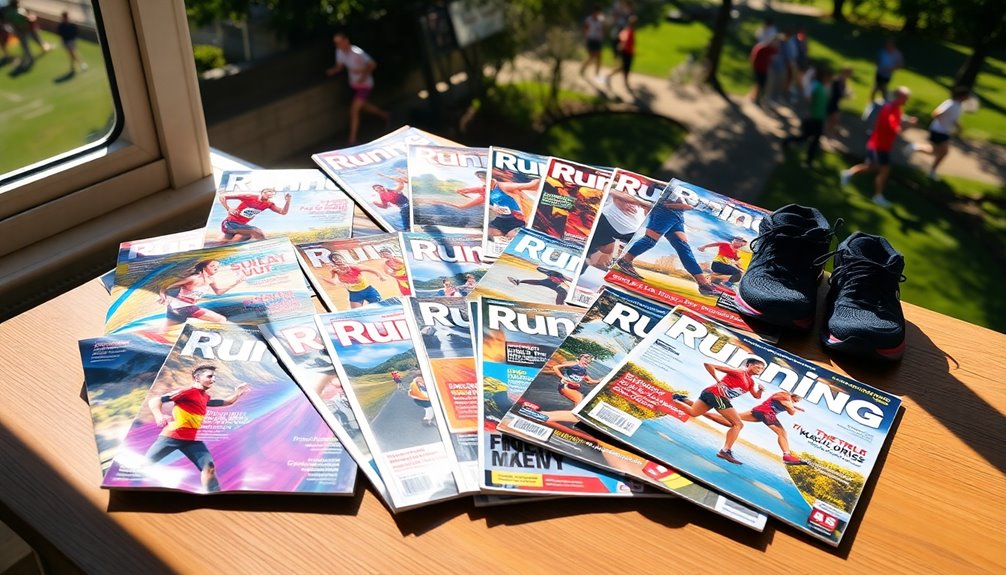Running magazines are fantastic sources of inspiration and practical tips for every runner. I love how they cover everything from training advice to nutrition and mental toughness. Some of the best options I’ve found include the 2025 Runners World Wall Calendar and the Runners World Training Journal. Plus, for beginners, “Running Your First Marathon” is invaluable. Each magazine has something unique to offer, and if you explore further, you’ll discover even more gems to enhance your running journey. Additionally, many running magazines often feature recommendations for the best running podcasts for motivation, which can be a great supplement to your reading. These podcasts provide insights from seasoned runners and coaches that can help you stay inspired and committed to your goals. By combining the written advice from magazines with the auditory motivation from podcasts, you can create a well-rounded approach to your running routine.
Key Takeaways
- Look for magazines that cover a variety of topics including training techniques, race coverage, and nutrition to keep your running routine fresh and engaging.
- Choose publications that cater to your skill level, whether you're a novice or an experienced runner, for relevant content and advice.
- Consider magazines that feature motivational stories and insights from both elite athletes and everyday runners to inspire your own journey.
- Publications with a visually appealing layout enhance reading enjoyment and can make complex topics more accessible and engaging.
- Regularly published magazines can provide ongoing inspiration and up-to-date information on the latest trends in the running community.
2025 Runners World Wall Calendar
If you're a dedicated runner looking for inspiration and practical guidance throughout the year, the 2025 Runners World Wall Calendar is a perfect fit for you. This calendar features stunning running photography, motivational quotes, and essential training tips. Each month, I find valuable advice on warming up and dressing right. Plus, it lists race dates nationwide, helping me plan my next event. With an impressive 4.5-star rating from fellow runners, it's clear this calendar resonates with many. Just a heads up, some users mentioned a missing day in May, which can affect summer tracking. Overall, it's a fantastic resource!
Best For: Runners seeking inspiration, practical training advice, and a way to track race dates throughout the year.
Pros:
- Beautiful running photography and motivational quotes to inspire daily.
- Provides practical training tips for warming up, dressing appropriately, and pacing.
- Includes comprehensive race dates across the country, aiding event planning.
Cons:
- Some users reported a missing day in May, which could disrupt tracking.
- Limited to a wall calendar format, which may not suit everyone's organizational preferences.
- May not provide detailed training plans, which some advanced runners might desire.
Runners World How to Make Yourself Poop: And 999 Other Tips for Runners
"Runners World How to Make Yourself Poop: And 999 Other Tips for Runners" is a treasure trove for anyone looking to enhance their running experience, especially beginners enthusiastic to dive deeper into the sport. I initially bought it for the humorous title, but I found the content incredibly informative and engaging. The practical tips cover everything from training to nutrition, making it a great resource for all levels of runners. While some advice may not suit everyone, I appreciated the balance of humor and serious insights. This book's definitely become a staple in my running journey, and I highly recommend it!
Best For: This book is best for runners of all levels, from beginners looking to improve their skills to seasoned athletes seeking practical tips and humor in their training journey.
Pros:
- Informative and humorous: Combines practical advice with a light-hearted tone, making it enjoyable to read.
- Comprehensive coverage: Addresses various aspects of running, including training, nutrition, and performance enhancement.
- Accessible to all: Suitable for a wide range of athletes, from casual 5K runners to more serious triathletes.
Cons:
- Mixed advice: Some tips may not be universally applicable or may require critical evaluation.
- Nutrition section concerns: Contains mildly fat-phobic content that may need re-evaluation for inclusivity.
- Repetitive information: May not offer new insights for those already well-versed in running knowledge.
Runners World Training Journal: Daily Motivation & Tips for Runners
The Runners World Training Journal stands out as an ideal companion for anyone serious about their running journey. With its vibrant colors and user-friendly design, I find it easy to fill in my training details flexibly over 52 weeks. The sections for race info, shoe tracking, and memorable runs keep me organized and motivated. I love the inspirational quotes sprinkled throughout, which push me to stay focused. Even though I’d appreciate more space for daily entries, it’s been invaluable for tracking my progress and setting goals, whether I’m a beginner or training for my next marathon. Additionally, the Runners World Training Journal features helpful tips and advice that cater to runners of all levels, making it one of the best running journals for motivation. The encouragement I receive from each page helps me maintain my enthusiasm, especially on the tough days. Overall, this journal has become an essential tool in my training arsenal, allowing me to reflect on my journey while striving for new achievements.
Best For: The Runners World Training Journal is best for runners of all levels, from beginners seeking guidance to experienced athletes tracking detailed training information.
Pros:
- Vibrant colors and user-friendly design make it easy to log training details over 52 weeks.
- Motivational quotes and tips throughout the journal keep users inspired and focused on their goals.
- Sections for race information and shoe tracking help maintain organization and progress monitoring.
Cons:
- Limited space for daily entries may not meet the needs of users wanting to write more detailed notes.
- Price concerns expressed by some users, who feel it could be more reasonable compared to other training tools.
- Potential imbalance between motivational content and personal writing space, as some users desire more room for personal notes.
Gone for a Run 2025 Daily Desk Calendar for Runners
For anyone looking to stay motivated throughout their running journey, the Gone for a Run 2025 Daily Desk Calendar is a perfect companion. I love how its 314 colorful pages offer over 300 original illustrated quotes that keep my spirits high. Each day, I can track my miles and training progress, which really helps me stay accountable. Plus, it's compact—just 5.25 x 4.25 inches—so it fits easily on my desk. With a solid 4.7-star rating and rave reviews, I've found it to be an inspiring gift for fellow runners. It's a must-have for anyone serious about their running goals!
Best For: Runners seeking daily motivation and a structured way to track their training progress.
Pros:
- Inspiring Content: Over 300 original illustrated quotes provide daily motivation to keep runners engaged.
- Compact Design: At 5.25 x 4.25 inches, it easily fits on any desk without taking up much space.
- Training Tracker: Includes a daily mile and training tracker to help users stay accountable for their running goals.
Cons:
- Limited Space for Notes: The compact size may offer insufficient space for detailed notes or reflections.
- Weekend Layout: Combined weekend pages might not suit those who prefer separate entries for Saturday and Sunday.
- Availability: As a calendar, it needs to be replaced annually, which may not be ideal for long-term planning.
Running Your First Marathon: The Complete 20-Week Marathon Training Plan
If you're a novice looking to tackle your first marathon, "Running Your First Marathon: The Complete 20-Week Marathon Training Plan" is your go-to resource. This guide breaks down everything from diet to injury management, ensuring you're well-prepared. I loved how it structures a 20-week plan, helping me build mileage gradually. Readers rave about their impressive marathon times, often achieving personal bests, which inspired me too. The practical advice on recovery and nutrition was invaluable. While some sections could use more depth, the book's straightforward approach keeps you focused and motivated. Trust me, it's a must-have for first-time marathoners!
Best For: Novice runners preparing for their first marathon who seek a structured and practical training plan.
Pros:
- Comprehensive coverage of essential topics like diet, hydration, and injury management, making it a well-rounded resource.
- Structured 20-week training plan that gradually builds mileage, suitable for runners already running 15-20 miles per week.
- Inspiring personal testimonials from readers who have successfully improved their marathon times, motivating newcomers.
Cons:
- Some readers desire more in-depth discussions on injury management to better prepare for potential challenges.
- The presentation of training tables in the Kindle version could be clearer, affecting usability for some.
- A few users felt that the content is somewhat basic and similar to information found in online blogs, limiting its uniqueness.
80/20 Running: Run Stronger and Race Faster by Training Slower
Emphasizing low-intensity training, "80/20 Running: Run Stronger and Race Faster by Training Slower" is perfect for aging recreational runners like me who want to enhance their performance without risking burnout. I discovered this method while searching for effective training strategies after years of running. It's transformed my approach, allowing me to run more miles while feeling energized. Since adopting the 80/20 philosophy, I've achieved personal records in both 5K and half-marathon races. The book's structured plans and scientific insights make it essential for anyone looking to improve their running experience. Give it a try; you won't regret it!
Best For: Aging recreational runners seeking to enhance their performance and enjoy their training without the risk of burnout.
Pros:
- Structured training plans for various race distances that are easy to follow.
- Scientific backing provides credibility to the training philosophy and methods.
- Increased mileage with lower intensity helps prevent exhaustion and injury.
Cons:
- Thin paper quality in the physical book may affect durability.
- Inadequate chapter labeling can make navigation challenging.
- Some readers may need to re-read sections for deeper understanding.
Runners World Your Best Stride: Optimize Your Natural Running Form
Runners World's "Your Best Stride" is an essential resource for anyone looking to refine their running technique, regardless of experience level. This thorough guide dives into ideal running form while respecting our unique body mechanics. I love how the practical exercises are clearly presented, allowing me to easily incorporate them into my routine—even doing squats while brewing coffee! The motivational insights from both elite and everyday runners inspire me to keep pushing toward my goals. Plus, the accessible language makes it enjoyable to read. After applying its teachings, I've noticed fewer aches and a more fulfilling running experience.
Best For: Runners of all experience levels looking to optimize their running technique and reduce injuries.
Pros:
- Comprehensive guide that caters to individual differences in running form and biomechanics.
- Practical exercises that are easy to integrate into daily routines, enhancing performance.
- Motivational insights from both elite and everyday runners that encourage ongoing improvement.
Cons:
- Some readers may find the suggestions require patience and time to yield noticeable results.
- The book's emphasis on biomechanics may not appeal to those seeking a more straightforward approach.
- Limited focus on advanced techniques for seasoned runners looking for elite performance enhancements.
Run Fast. Eat Slow.: Nourishing Recipes for Athletes: A Cookbook
For anyone passionate about running and healthy eating, "Run Fast. Eat Slow." is a must-have. Co-authored by chef Elyse Kopecky and Olympian Shalane Flanagan, the book prioritizes nourishment over calorie counting. Each recipe, like Teff Pumpkin Pancakes and Curry Lentil Soup, highlights its nutritional benefits, making meal prep both simple and rewarding. I love the beautiful photographs and the storytelling that enriches each dish. Plus, it addresses common runner issues, offering practical solutions. If you're looking to fuel your runs with delicious, wholesome meals, this cookbook will inspire you every step of the way.
Best For: Healthy eaters and runners looking for delicious, nutrient-dense recipes to fuel their performance.
Pros:
- Nutrient-focused recipes: Each dish is designed to nourish rather than count calories, ideal for athletes.
- Accessible cooking: Recipes are straightforward, making them suitable for both novice and experienced cooks.
- Engaging storytelling: Each recipe comes with a narrative that enhances the cooking experience and connection to food.
Cons:
- Lack of metric measurements: Some users find the absence of metric conversions limiting for international cooks.
- Ingredient availability: While many ingredients are common, some may require planning ahead for grocery shopping.
- Limited dietary options: The book may not cater to specific dietary restrictions or preferences, such as veganism or gluten-free diets.
Runners World Train Smart, Run Forever Book
As a dedicated runner, I found the "Runners World Train Smart, Run Forever" book to be an invaluable resource, especially for those of us managing the challenges of aging while maintaining our passion for the sport. After a knee replacement, I struggled to get back to running, but this book's practical advice for injury prevention and cross-training has been a game changer. I appreciated its engaging writing and solid research, even if some sections felt less relevant for experienced runners. I wish I'd discovered it sooner; it's now a staple in my training, and I've even ordered copies for friends!
Best For: This book is best for mature runners seeking practical advice on injury prevention and effective training strategies to enhance their running experience.
Pros:
- Engaging writing style that blends practical advice with scientific research.
- Comprehensive injury prevention techniques specifically tailored for aging runners.
- Valuable resource for both novice and experienced runners looking to refine their training approach.
Cons:
- Some chapters may feel irrelevant to seasoned runners, potentially leading to a disconnect.
- The initial sections of the book take time to reach the core training content.
- Limited depth of information for experienced runners; might not offer new insights for those with extensive training backgrounds.
The Runners Guide to the Meaning of Life
Exploring the intersection of running and life, "The Runners Guide to the Meaning of Life" resonates with those seeking inspiration beyond the physical act of running. Amby Burfoot's essays reflect on why we run, touching on themes like courage, personal growth, and the cyclical nature of existence. It's not just about racing; it's a journey of self-discovery. Burfoot's experiences, from winning the Boston Marathon to his role as a Runners World editor, enrich these insights. Despite mixed reviews, I find the book's motivational quotes and reflections on life's challenges deeply resonant, offering guidance for every runner's path.
Best For: Those seeking inspiration and philosophical insights into running and life, particularly younger runners and those new to the sport.
Pros:
- Inspiring content that encourages personal growth and self-discovery through running.
- Concise and accessible format, making it easy to read and digest quickly.
- Motivational quotes and reflections that resonate with various life challenges.
Cons:
- May be perceived as too simplistic for seasoned runners looking for advanced insights.
- Some readers find the large font and brevity lacking depth and substance.
- Mixed reviews suggest it may be better suited for a younger audience rather than experienced athletes.
Runners World Complete Book of Women's Running
The "Runners World Complete Book of Women's Running" stands out as the perfect choice for beginner and slightly experienced female runners. It offers essential guidance on everything from picking the right shoes to injury prevention. With training plans tailored for various skill levels, I found it incredibly structured and easy to follow. The motivational tone truly empowered me to embrace my running journey, regardless of age. While some seasoned runners might find it basic, I appreciate its supportive approach. Plus, the health and safety tips are invaluable, especially for women. Overall, it's a fantastic resource that inspires confidence and progress.
Best For: Beginner and slightly experienced female runners seeking comprehensive guidance and motivation for their running journey.
Pros:
- Comprehensive guidance on essential topics such as shoe selection, injury prevention, and training plans tailored for various skill levels.
- Motivational tone that empowers readers to embrace running and overcome frustrations, fostering a positive mindset.
- Health and safety tips specifically tailored for women, addressing concerns like running during pregnancy and safety while running alone.
Cons:
- Some experienced runners may find the content lacking depth in certain areas, particularly regarding injuries.
- The writing style can be perceived as lengthy and repetitive, which may deter some readers.
- There are concerns about outdated nutritional advice, which may not align with current recommendations.
Sports Nutrition for Young Adults Guide
Are you a young athlete looking to boost your performance through smart dietary choices? I recently picked up the "Sports Nutrition for Young Adults Guide," and it's been a game-changer. Written in an easy-to-read format, it offers practical dietary principles that really helped me understand how to fuel my body. The recipes and meal plans are fantastic, making it easier to implement healthy habits. While some sections felt repetitive, the overall guidance was straightforward. It's a great resource for young athletes like us, encouraging better eating habits and enhancing performance. Give it a shot; it might just elevate your game!
Best For: Young athletes seeking straightforward nutrition guidance to enhance their performance through informed dietary choices.
Pros:
- Easy-to-read format that simplifies complex nutritional concepts.
- Includes practical recipes and meal plans to encourage healthy eating habits.
- Valuable resource for parents and educators teaching nutrition to young athletes.
Cons:
- Some content may be repetitive across different sections.
- A few readers found the information lacking depth or new insights.
- Not ideal for fussy eaters or those on a limited budget.
Young Athletes Ultimate Guide to Mental Toughness
For young athletes enthusiastic to enhance their mental toughness, "Young Athletes Ultimate Guide to Mental Toughness" by Chad Metcalf stands out as an essential resource. Metcalf, a former Navy SEAL, presents practical strategies that go beyond sports, focusing on resilience and overall well-being. His five-step system teaches us to embrace challenges and view setbacks as growth opportunities. I found the tips on goal-setting and managing pressure invaluable. With real-life examples from experienced coaches, this book inspires confidence and encourages long-term success. Whether you're on the field or facing life's hurdles, Metcalf's insights apply universally, making it a must-read for personal growth.
Best For: Young athletes, coaches, and parents looking to develop mental toughness and resilience in sports and life challenges.
Pros:
- Provides a structured five-step system for building mental resilience and character.
- Includes real-life examples and insights from experienced coaches, enhancing credibility and relatability.
- Offers practical strategies for goal-setting, managing pressure, and balancing sports with other life activities.
Cons:
- May not delve deeply into specific sports training techniques, as the focus is primarily on mental toughness.
- Some readers might find the content too general if they are looking for niche or sport-specific advice.
- The book's principles may require consistent application and practice, which could be challenging for some young athletes to maintain.
Factors to Consider When Choosing Running Magazines

When I choose a running magazine, I consider several key factors that can make or break my experience. Content variety, target audience, and the frequency of publication are all essential to guarantee I get the most relevant information. Plus, visual appeal and price matter too, especially when I'm looking for something that fits my budget and style.
Content Variety and Focus
Choosing the right running magazine can be a game changer, especially if you want content that aligns with your interests and goals. I always look for a variety of topics, like training tips, race coverage, and nutrition advice, to guarantee it meets my needs as a runner. Magazines that cater to different skill levels are essential for gaining insights relevant to my experience, whether I'm just starting out or pushing for a personal best. I also appreciate publications that feature expert contributions from coaches and seasoned runners, offering diverse viewpoints. Keeping an eye on how frequently they update their content guarantees I stay informed about the latest trends and best practices in the running community.
Target Audience and Skill
Understanding the target audience and skill level of a running magazine can make all the difference in finding the right fit for your running journey. Some magazines cater specifically to beginners, while others focus on advanced runners or even specific demographics like women or young athletes. It's essential to evaluate if the magazine includes training plans and advice that match your current skill level. I look for content that aligns with my interests, whether it's marathon training, trail running, or injury prevention. The tone matters too; a motivational, supportive approach is great for novices, while experienced runners might prefer technical, data-driven articles. Finally, contributions from credible experts can greatly enhance the quality of information I rely on.
Frequency of Publication
The frequency of publication plays an essential role in my experience with running magazines. Some magazines come out monthly, while others might publish bi-monthly or quarterly. I've found that monthly issues keep me engaged with the latest training techniques, race results, and gear reviews, helping me stay current with trends in the running community. On the other hand, bi-monthly or quarterly magazines often dive deeper into topics, offering in-depth articles and long-term strategies that I appreciate for a more thorough view. When choosing a magazine, I consider my reading habits—if I want immediate updates or prefer thorough explorations. Ultimately, it's about finding the right balance that fits my interests and keeps my passion for running alive.
Visual Appeal and Design
When I pick up a running magazine, the visual appeal can make all the difference. Vibrant photography and appealing layouts draw me in, making me feel connected to the content right away. I appreciate high-quality design elements like clear typography and effective color use; they enhance readability, making information accessible for runners of all skill levels. I tend to stick with magazines that have a consistent, aesthetically pleasing design, as it fosters a sense of familiarity and loyalty. Infographics and visually striking charts break down complex training data and nutritional info, making them digestible for everyone. Plus, a well-designed cover that reflects the running community truly catches my eye on the newsstand.
Price and Subscription Options
Choosing a running magazine involves considering several key factors, and price is often at the top of that list. Subscription costs can vary greatly, usually ranging from $10 to $50 annually, so it's smart to shop around. I've found that many magazines offer promotional rates for first-time subscribers, which is a great way to save some cash. Don't forget to check if they have digital options; these are often cheaper and might provide extra content. Some publications even allow bundling with related magazines for added savings. Finally, I appreciate magazines that offer flexible subscription terms, like trial periods or easy cancellation, so I can evaluate the content without a long-term commitment. Happy reading!
Frequently Asked Questions
What Are the Benefits of Reading Running Magazines?
Reading running magazines has really transformed my approach to the sport. They offer fresh training tips and insights from experienced runners that motivate me to push my limits. I love discovering new gear and nutrition advice tailored for runners like me. Plus, the inspiring stories of fellow athletes remind me that I'm not alone in my journey. Overall, these magazines keep me informed, inspired, and excited to lace up my shoes and hit the pavement.
How Can Running Magazines Enhance My Training Routine?
Running magazines really enhance my training routine by providing fresh insights and tips. They keep me motivated with inspiring stories from fellow runners and expert advice on techniques. I often discover new workouts and nutrition strategies that I can easily incorporate into my regimen. Plus, reading about others' journeys reminds me that I'm not alone in my struggles and triumphs. It's like having a supportive running community right at my fingertips!
Are There Magazines Specifically for Beginner Runners?
Did you know that nearly 80% of new runners quit within the first few months? That statistic really hits home for me. Yes, there are magazines specifically for beginner runners! They offer tailored advice, training plans, and motivational stories to keep you engaged. I've found them incredibly helpful when starting out. They not only provide guidance but also create a sense of community, which makes running much more enjoyable and less intimidating.
How Often Should I Read Running Magazines?
I think reading running magazines should be a regular habit, maybe once a month or even more if you're really into it. I find they keep me motivated and informed about new techniques, training plans, and gear. If you're preparing for a race or just looking for inspiration, diving into an article can spark new ideas. So, I'd say pick a frequency that fits your schedule and keeps you excited about running!
Can I Find Running Magazines in Digital Format?
I was scrolling through my tablet one evening when I stumbled upon a treasure trove of running magazines in digital format. Yes, you can definitely find them online! Many popular running magazines offer digital subscriptions, letting you read anywhere, anytime. Plus, some apps even curate articles from various sources, so you won't miss out on the latest tips and inspiration. It's convenient, and I love having access to a wealth of information at my fingertips!
Conclusion
So, whether you're chasing that next mile or gearing up for your first marathon, these magazines and resources are here to light the way. Imagine flipping through pages filled with tips that could transform your run or even discovering the secret to conquering mental hurdles. What if the next great piece of advice is just a page away, waiting to inspire you? Immerse yourself, and who knows? You might just find the motivation you didn't know you needed.























